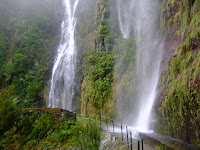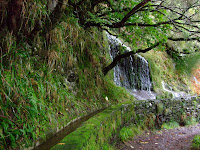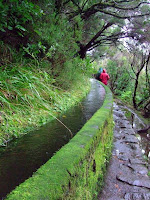 One of the things one must do when visiting Madeira is a levada walk. There are over 2000km of levadas on Madeira, some dating back to when the Portuguese first colonised the island and some quite modern. Initially these were irrigation channels constructed to bring water from the mountains to the lower lying agricultural land; now some are used as feeds for hydro-electricity generation.
One of the things one must do when visiting Madeira is a levada walk. There are over 2000km of levadas on Madeira, some dating back to when the Portuguese first colonised the island and some quite modern. Initially these were irrigation channels constructed to bring water from the mountains to the lower lying agricultural land; now some are used as feeds for hydro-electricity generation. Regardless of their initial purpose they now generate healthy revenues for the companies that organise levada walks for tourists. Because the levadas follow the contours to bring the water down gradually the gradients are very slight making the walks quite approachable for any level of fitness.
Regardless of their initial purpose they now generate healthy revenues for the companies that organise levada walks for tourists. Because the levadas follow the contours to bring the water down gradually the gradients are very slight making the walks quite approachable for any level of fitness.We chose the 25 Fontes Walk as it was well recommended in the guidebooks. Our taxi driver from yesterday was full of dire warnings regarding attempting a levada walk on our own given the instability of the paths after the recent heavy rain and the only way to access many of the walks is either a guided tour or with a rental car.
 We were quite pleased that we had not chosen the rental car option when, after stopping for a coffee and comfort break, having climbed from sea-level to 1007m, the driver discovered that the road was closed. So it was all the way back down to the coast and up again via another route. This second route would have dissuaded any rental car driver that was not absolutely confident of reaching the final destination. We finally arrived at the Paul da Serra plateau at 1500m. This is the largest flat area on the island (3km by 4km) and we drove across it in low cloud, unable to see a thing. Finally, we arrived at our destination, Rabacar and donned our wet weather gear; however, it was not long before our boots were wet through as the rain kept pouring down.
We were quite pleased that we had not chosen the rental car option when, after stopping for a coffee and comfort break, having climbed from sea-level to 1007m, the driver discovered that the road was closed. So it was all the way back down to the coast and up again via another route. This second route would have dissuaded any rental car driver that was not absolutely confident of reaching the final destination. We finally arrived at the Paul da Serra plateau at 1500m. This is the largest flat area on the island (3km by 4km) and we drove across it in low cloud, unable to see a thing. Finally, we arrived at our destination, Rabacar and donned our wet weather gear; however, it was not long before our boots were wet through as the rain kept pouring down.The first levada walk took us out to a reasonably spectacular waterfall but we could not quite make it to the viewpoint as another temporary waterfall was obliterating the path. We retraced our steps partway and descended to join the second levada that would take us to the 25 Fontes or fountains.
 Arriving there, all we saw was another impressive waterfall. The guide explained that usually there are 25 separate outlets from the rock face with a smallish waterfall running down the centre. All of that was lost in the excesses of water that were cascading down.
Arriving there, all we saw was another impressive waterfall. The guide explained that usually there are 25 separate outlets from the rock face with a smallish waterfall running down the centre. All of that was lost in the excesses of water that were cascading down.After that it was time for lunch and the guide indicated that we would head down another path by a levada for our lunch break. We followed others and set off and it was not until the leaders came across a sign propped against the side of the path saying, in six different languages, that it was not safe to proceed that questions arose; like ‘Where is the lunch spot?’ ‘Where is the guide?’ ‘Where is the rest of the party?’ and so on. We decided to retrace the kilometre or so that we had walked and came across the rest of the party happily, albeit soggily, enjoying their lunch right back near the 25 Fontes. Apart from the levada beside the path and the gentle gradients, we could have been walking anywhere in NZ's Fiordland; the trees were dripping with mosses, lichens and rain; we felt very much at home.
 Replenished and reunited we returned by the route we had taken until we met the stairs that had brought us down to the lower levada. Instead of climbing the stairs we carried on following the levada, most of the time walking on a buried pipe that had joined our route. A couple of kilometres further on the path, levada and pipe all entered a tunnel. The guide produced some torches and we set off through the 800m long tunnel.
Replenished and reunited we returned by the route we had taken until we met the stairs that had brought us down to the lower levada. Instead of climbing the stairs we carried on following the levada, most of the time walking on a buried pipe that had joined our route. A couple of kilometres further on the path, levada and pipe all entered a tunnel. The guide produced some torches and we set off through the 800m long tunnel. Although we all had sodden shoes, socks and feet, most of us had been puddle-jumping all day avoiding the worst of the standing water on the path or the cascading water that ran across the path occasionally from the overflowing levadas. It had all been a waste of time because the floor of the tunnel was a stream which was ankle deep by the time we exited and there was nowhere else to walk but through the water.
Although we all had sodden shoes, socks and feet, most of us had been puddle-jumping all day avoiding the worst of the standing water on the path or the cascading water that ran across the path occasionally from the overflowing levadas. It had all been a waste of time because the floor of the tunnel was a stream which was ankle deep by the time we exited and there was nowhere else to walk but through the water. However, the other side of the mountain was bathed in the most welcome sunlight which we all enjoyed as we made our way out to the collection spot to wait for the bus which took us back to Funchal via a welcome coffee stop at Calheta where the pipe had terminated in a hydro-electric station.
However, the other side of the mountain was bathed in the most welcome sunlight which we all enjoyed as we made our way out to the collection spot to wait for the bus which took us back to Funchal via a welcome coffee stop at Calheta where the pipe had terminated in a hydro-electric station.




No comments:
Post a Comment